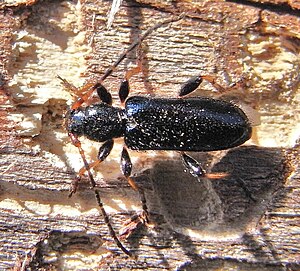Red-legged disc buck
| Red-legged disc buck | ||||||||||||
|---|---|---|---|---|---|---|---|---|---|---|---|---|

Red-legged disc buck ( Poecilium rufipes ) |
||||||||||||
| Systematics | ||||||||||||
|
||||||||||||
| Scientific name | ||||||||||||
| Poecilium rufipes | ||||||||||||
| ( Fabricius , 1776) |
The red-legged disc Bock ( Poecilium rufipes , Syn. : Phymatodes rufipes , Phymatodellus rufipes ) is a beetle from the family of longhorn beetles . The species resembles the somewhat larger species Poecilium lividum and the significantly larger variable Schönbock . The animal, which is rare in Central Europe, is found mainly in Southern Europe.
Description of the beetle
The body is flat and elongated. It reaches a length between five and eight millimeters. He is hairy.
The head is wider than it is long (Fig. 1). The eleven-link antennae are thread-shaped. In the male they almost reach the tip of the abdomen, in the female they clearly protrude above the middle of the elytra. The second antenna element is not ring-shaped, but longer than it is wide. However, it is shorter than the third and fourth antenna elements combined. The first antennae are reddish yellow, the following ones are usually dark. Occasionally the whole antennae are also red-yellow.
The kidney-shaped eyes encompass the antennae base from behind, from the front parts of the eye can be seen above and below the antennae (Fig. 1). The edges of the two eyes are less far apart on the vertex than the bases of the antennae.
The pronotum is rounded at the sides. It has no calluses, but is regularly punctured almost everywhere (Fig. 3).
The wing covers are metallic blue or purple. They run parallel and are rounded off together in a semicircle at the end. The puncturing is rough (Fig. 4). The elytra are long hairy.
The legs are two-tone. Splints and tarsi, but only the base of the legs, like the base of the antennae, are red-yellow. The thighs are stalked at the base, thickened towards the tip and dark there. The joint cavities of the front hips are open to the rear. The front hips are close together and are not separated by the rearward-facing process of the front chest. The tarsi are apparently four-limbed, the very small fourth limb is hidden in the section of the lobed third tarsal. The first segment of the hind tarsi is not significantly larger than the second and third segment combined (Fig. 5, length of tarsi 1 to 3 marked on the black line). The claws are imperforate at the base.
| Pictures of Poecilium rufipes : | |
 Fig. 1: Front view 
|
 Fig. 3: Side view Fig. 4: Puncturing the wing cover  
|
| Fig. 2: Puncture of the pronotum | Fig. 5: Hind tarsus, border of the 1st, 2nd and 3rd limbs black |
biology
The red-legged disc buck is a warmth-loving species. In Central Europe it is mainly found in warm areas and in warm years. The larva develops in the dry branches of various deciduous trees, mainly hawthorns . Also blackthorn , blackberries and others are called. Whether oak and hazel are host plants is controversial. The development time is one year. The adult beetle is found in Central Europe only in early summer, mainly on hawthorn.
distribution
The distribution area of the beetle extends over southern Europe and southern central Europe. The species is absent in the north. The northern limit of distribution runs through Germany. To the east, the beetle can still be found in Turkey and the Middle East.
literature
- H. Joy, KW Harde, GA Lohse: Die Käfer Mitteleuropas , Vol. 9. Spectrum Academic Publishing House in Elsevier, Munich 1966, ISBN 3-827-40683-8
- Adolf Horion: Faunistics of the Central European Beetles, Bd. XII . Überlingen-Bodensee 1974
Individual evidence
- ^ Adolf Horion: Faunistics of the Central European Beetles, Vol. XII . Überlingen-Bodensee 1974
- ↑ Poecilium rufipes in Fauna Europaea. Retrieved December 20, 2010